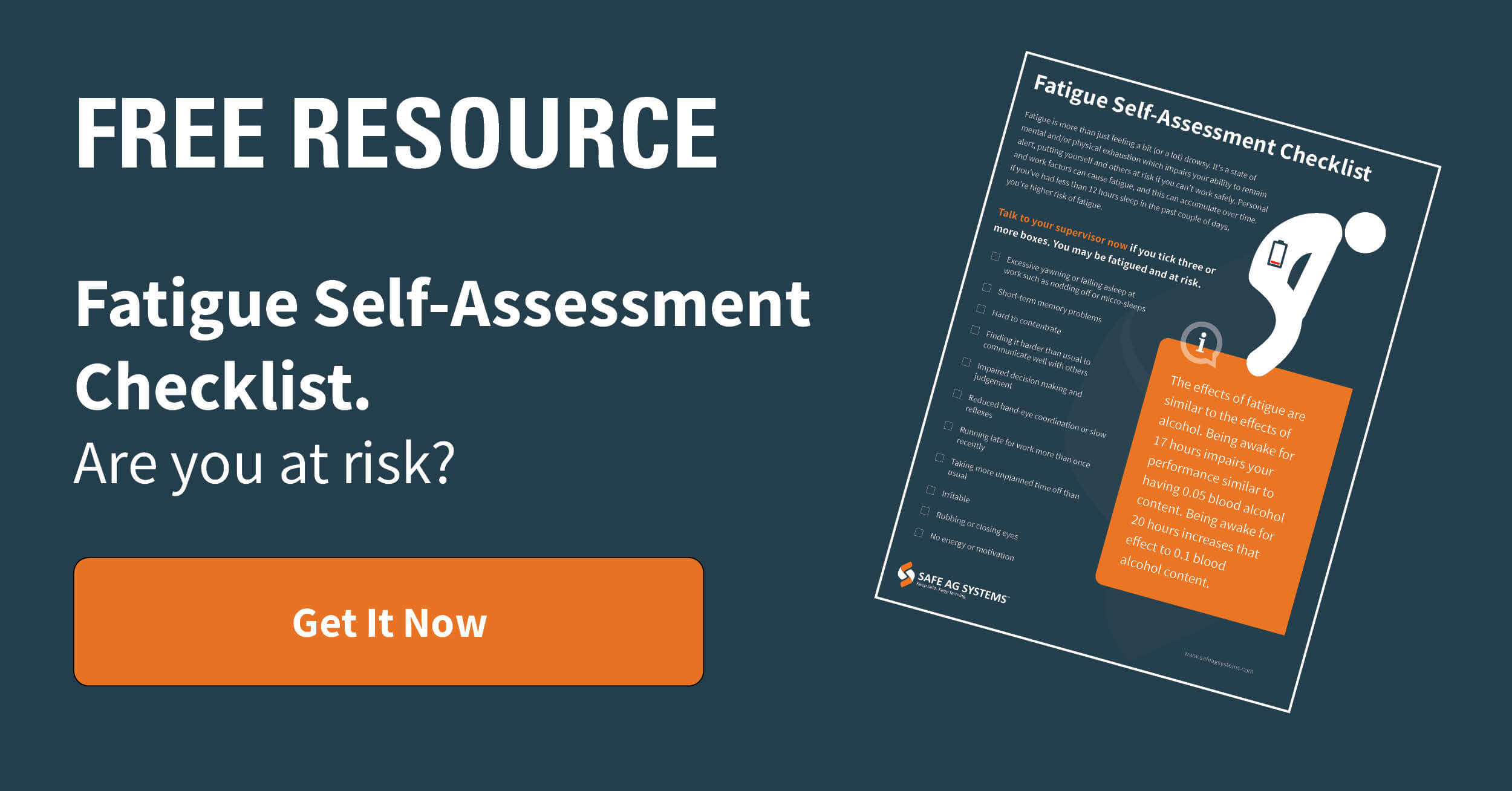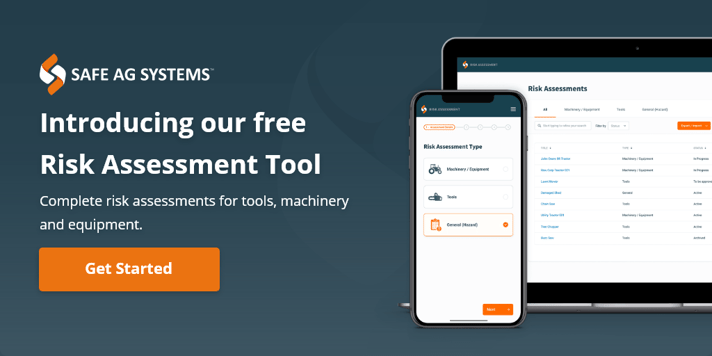Yawning. Irritable. Struggling to stay awake. No energy or motivation. Can’t concentrate. Rubbing or closing eyes. Nodding off. Poor short-term memory. Near misses.
No, I’m not talking about me. I’m talking about the common signs of fatigue which we all experience from time to time. These are also the signs that fatigue could lead to something going very wrong. Whether that’s in a workplace or on the road, it’s something we want and need to avoid.
Here's what you can expect:
- What is fatigue?
- Are you Zoned Out?
- Fatigue self-assessment checklist
- Change the narrative in your workplace
- Fatigue Management and Farm Safety
- What can you do?
So, what is fatigue?
Fatigue is one of the most common hazards on a farm, and most underrated risk for everyone. It’s more than just feeling a bit tired. Fatigue is that overall feeling of tiredness or lack of energy. It interferes with normal daily activities and functioning, impacts on alertness and slows reaction times. Your ability to communicate can be affected, as well as mood.
Other effects of fatigue can include:
- Reduced productivity and taking longer to get things done
- Microsleeps
- Short term memory issues
- Reduced the ability to think creatively or logically
- Not noticing things around you (think hazards or things that can result in injury or damage)
The nature of agriculture is that we work the hours we need to get the job done. Our work rarely happens between Monday to Friday, 9 to 5. When we have seasonal peaks like cropping or harvest, we do what it takes to get the job done.
Are you Zoned Out.
I bet you could think of a time recently where you nearly dozed off or zoned out while working or operating equipment (aka a near-miss), which gives us a bit of a fright. That’s sadly normal and we all have these from time to time. When inattention does happen, the heart rate increases and we get a shot of adrenaline which wakes us up.
Do you remember what you did? Did you think ‘phew, that was lucky!’ and keep going anyway? Congratulations, you were lucky enough to survive a fatigue related incident. Not everyone is so fortunate.
Being awake for 17 hours results in the same behaviour as having 0.05% blood alcohol content (BAC). 20 hours awake can be the same as 0.10% BAC. We allow people to drive, do dangerous work or operate machinery for extended periods of time, especially during peak times. Perhaps this needs to change – after all you wouldn’t let someone operate your equipment if they were 0.05% BAC or higher. Would you?
Even though we know the logic, we actually don’t treat fatigue as a serious risk and therefore we don’t talk about it in any real sense. According to Prof. Drew Dawson of CQU, who is a world-leading expert on sleep and fatigue management:
“We need to change the narrative around fatigue”.
It needs to be OK and encouraged to speak up about being tired without fear of retribution or derision from others.
Fatigue Self-Assessment Checklist.
Safe Ag Systems has a Fatigue Self-Assessment Checklist template you can use. Our checklist covers a range of fatigue indicators and is an easy to use check box guide. Share this with your workforce, and use it yourself. Print it out and stick it up in break rooms, sheds, vehicles or anywhere you think workers might see it. Encourage workers to use this regularly, and continue to encourage the narrative around fatigue.
You can change the narrative in your workplace.
Prof. Dawson suggests you ask your workforce this question: “tell me the dumb stuff people do when they are fatigued”. This takes away the secretive narrative around fatigue and by asking this kind of question, you’ll probably get some pretty honest answers.
Some workplaces are frightened to talk about fatigue, mainly because they’re unsure of how to manage it. In some cases, the conversation doesn’t happen because there’s a thought that it will affect overtime for workers, impact rosters, identifies a need for increased staffing levels and other factors which could hit the bottom line. The reality is some of this may be needed but that’s not the only solution. Some solutions don’t require spending money.
Businesses are encouraged to create an environment where it’s OK to say ‘I’m feeling really tired.’ This comment could save thousands of dollars. A worker is reporting a hazard so that you can manage it appropriately rather than creating an incident which could be costly.
Managing fatigue doesn’t mean sending a worker home, or telling someone to ‘toughen up’. If someone raises an issue of live electrical wires exposed in a workplace, or a chemical spill, you don't ignore it. These, and fatigue are real risks and they’re dangerous when left uncontrolled.
If someone does alert you to the fact they are fatigued, consider jobs they can do that aren’t as high risk. Of course, if a worker is regularly saying they are tired, then that might invoke a different kind of conversation as there might be other issues which need addressing so they are fit for work.

Fatigue Management and Farm Safety
Fatigue management is not just about rostering, although that plays a part. It’s actually about sleep. To be operating at a safe level, research tells us the average person needs AT LEAST 6 hours of sleep a night, ideally 7 – 7.5hrs of uninterrupted, good quality sleep, depending on the individual.
While you can’t manage how people sleep, there are risk factors to consider in managing fatigue in a workplace. This is where rostering can come in to it, consider:
- Hours worked per week – up to 45 hours per week shouldn’t impact as much as if someone is working 72 hours a week or more. Try to keep hours reasonable even during peak seasons
- Shift duration – less than 10 hours a shift is good, 14 hours or more is dangerous
- Break duration between shifts – 14 hours or more is good, 10 or less is not ideal
- Night work – between 8pm and 8am, try to limit work done during this time. The more hours worked in this period, the greater the risk
- Reset frequency – how long before a worker gets time off – if it’s more than 12 days before a break, the risk is higher than a break after 6 days
What can we do now?
We know peak seasons increase risks when it comes to fatigue. Make sure you assess and manage that risk.
- Consider increasing the rotation of tasks, especially during overnight shifts.
- Encourage your workers to get some rest, and keep everyone hydrated. Dehydration makes your body work harder, causing fatigue and reduced physical and mental performance.
- If you can, rotate tasks so workers get regular breaks in shaded, heated, or air-conditioned areas, especially during extreme heat or cold.
Maintaining a balanced diet can also really help. The right nutrition will help the body cope with the stressors of long hours, physical work and peak times.
If you haven’t already, start planning for identifying and assessing the risk of fatigue in your workplace, start the narrative with your workforce and work on how you’re going to manage it.
Disclaimer: Content on this website may be of relevance to users outside of Australia, but content links and examples are specific to Australia. Please check with your local authority for your country and industry requirements.












